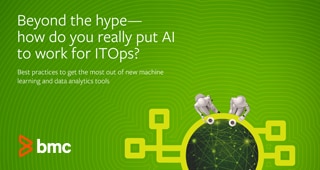
As IT service delivery becomes more complex and dynamic, forward-thinking IT leaders are turning to Artificial Intelligence for IT Operations (AIOps). By leveraging machine learning and analytics on a big data platform, AIOps can help to resolve IT issues more efficiently and help to identify opportunities for automation. An AIOps platform that ingests large volumes of streaming and batch-monitoring data from multi-cloud environments provides visibility and insights for individual teams within an IT organization and for teams across interdependent IT functions.
In a 2017 BMC survey of 1000 CIOs & senior IT professionals, 80% said they need to rethink their IT management approaches, and 78% said they would be looking to Artificial Intelligence to address complexity.
One of the many areas where AIOps can add value is IT service ticket analytics.
AIOps natural language processing for service tickets
Digital enterprises face an ever-increasing volume and velocity of IT service tickets. An AIOps platform uses machine analysis to keep up with the pace and volume of data while enabling correlation between the tickets, incidents, changes, and/or performance data. Using natural language processing (NLP) on the unstructured data in tickets (e.g., “Description” or “Notes”) yields insights into the problems driving the tickets that might otherwise go unnoticed and unaddressed.
Service ticket templates typically have a finite list of choices or categorizations. Users who open tickets can (or sometimes, “must”) choose from a list of options to self-classify the ticket issue or subject. Often, they also have the option to specify profile information such as the department where they work or a user ID.
When the finite list of categorizations doesn’t describe a user’s issue, or the user can’t find a choice with which they are happy, they will typically choose the default bucket of “Other”. When a user selects “Other,” the details of their issue or concern are going to be in the unstructured descriptions that they provide.
NLP algorithms can go through this free-form text and “cluster” issues based on the free-form text specified anywhere in the service ticket. This is particularly useful if the categories have not been kept up to date by the service desk team or by the ticketing system itself. A lot of these tickets can end up uncategorized, or the information provided can be difficult to extract without a big data platform that quickly handles the large volume data set and applies the NLP algorithm to the data set.
NLP algorithms for specific languages include ways to remove “stop words” in free-form text fields such as “the”, “a”, “an” and so on. They can cluster details about service tickets by two-word pairs that are included somewhere in the large volume of uncategorized tickets – not necessarily in sequence but anywhere in any one of the text fields. One of the pairs could be something like, “Account lockout” or “Access denied.” If the system includes incident data from log files, the two-word pair could be something like “Incorrect format,” or “Command failed.”
An event clustering visual like the one shown in the example below can quickly help you pinpoint the key word pairs that occur far more frequently compared to others.

This visualization and drill-down to the actual incidents associated with each cluster can help you quickly determine where to prioritize problem resolutions related to service tickets.
Beyond NLP for AIOps
Being able to leverage natural language processing (NLP) against the volume of service ticket information provides a great example of leveraging an AIOps platform.
With a TrueSight AIOps platform in place, you can also do the following:
- Predict future performance issues with dynamic baselining
- Forecast resource utilization, including public cloud cost, with capacity analytics
- Focus on the most likely source of a problem with probable cause analytics
- Discover issues captured in logs of a problem with log analytics
- Identify problems driving incidents with anomaly detection
For more information, see the AIOPs eBook:
https://www.bmc.com/forms/elevate-it-operations-aiops-ebook.html
Get practical guidance for AIOps
These postings are my own and do not necessarily represent BMC's position, strategies, or opinion.
See an error or have a suggestion? Please let us know by emailing blogs@bmc.com.







